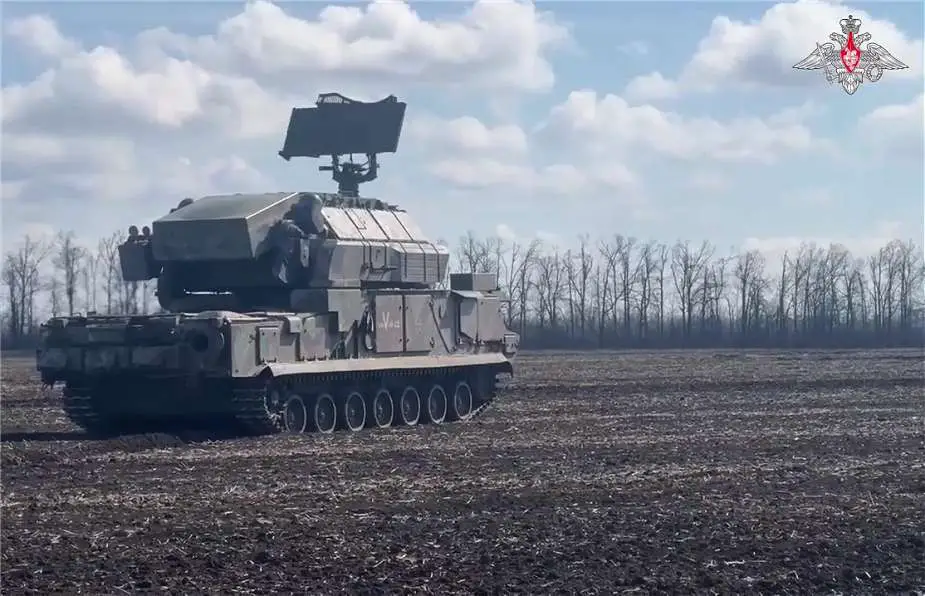According to information released by the Russian Ministry of Defense (MoD) on April 14, 2024, the Tor-M2U, one of the latest generations of the Tor mobile air defense missile system, has successfully intercepted and destroyed rockets launched by the American HIMARS and Ukrainian Vilkha Multiple Launch Rocket Systems (MLRSs) thanks to the use of new fire control system using AI (Artificial Intelligence) algorithms.
Follow Army Recognition on Google News at this link

Russian TOR-M2U air defense missile system in an undisclosed area in Ukraine. (Picture source Russian MoD)
The TOR-M2U is equipped with a new battlefield fire control missile system that uses AI (Artificial Intelligence) algorithms to recognize, classify, and prioritize targets, and it is capable of engaging up to four threats simultaneously. The Russian army received the first Tor-M2U missile systems at the end of 2014, and they entered service in 2015. This air defense system was first publicly unveiled in May 2014 during the Victory Parade in Moscow.
The TOR-M2U is a modernized version of the Russian TOR-M2 series of surface-to-air missile systems, designed primarily for anti-aircraft defense. It is capable of intercepting a variety of aerial threats including aircraft, helicopters, and precision-guided munitions. Mounted on a tracked vehicle chassis, the TOR-M2U boasts high mobility, enabling it to operate effectively across various terrains. This makes it particularly suitable for protecting mobile military units and strategic installations. The system is equipped with sophisticated radar and missile technology that allows it to track and engage multiple targets simultaneously, providing robust air defense capabilities in high-threat environments.
The Tor-M2U uses the proven 9M331 surface-to-air missile (SAM) which is optimized to destroy small-sized maneuvering targets. The air defense system is also able to fire a full range of missiles including the 9M338, 9M338GN, 9M338D, 9M338K, 9M338KUD, 9M339, 9M339D, 9M339KU, 9M339UD, and P3B-MD (export model of 9M338K). The missile is guided over a radio command link. The guidance starts as soon as the weapon enters the beam produced by the phased array and terminates when the missile hits the target. The high guidance accuracy combined with the powerful warhead enables the missile to effectively engage a wide range of air threats, including highly maneuverable (up to 10 g) and low-vulnerable ones. Tor-M2U system is capable of detecting up to 40 targets simultaneously; sorting them by degree of threat, tracking and attacking four targets using four missiles launched one after another. The TOR-M2U can destroy aerial targets with a firing range of up to 12 km flying an altitude from 10 m to 1,000 m.
The missile of the Tor-M2U air defense system uses a radio-command missile guidance principle. The target acquisition radar scans the surroundings while it is either moving or stationary, detects and identifies targets. The computing devices analyze the situation, prioritize the detected targets, and generate targeting information for the guidance radar. The guidance radar (stationary or at a short halt) locks on to the target, assumes its automatic tracking, and calculates the time instant when the SAM is to be launched to attack it. Then, it locks on to the SAM to track it automatically and guides it toward the target by radio commands automatically. In addition to these functions, the guidance radar controls the missile's war-load. It sends a delay command to the weapon's electronic fuze depending on the target-to-missile approach speed, thereby providing for the plastering of the target with a host of fragments at the required instant. In the event of a miss, the missile's self-destruct device is activated.
The Tor short-range surface-to-air missile system is a critical asset for Russia in its military engagements, particularly in the ongoing conflict with Ukraine. According to British military intelligence, the system has proven largely effective in countering Ukrainian attacks at the frontlines. This underscores the pivotal role of ground-based air defense systems in the dynamic and crucial contests of modern warfare, where both Russia and Ukraine strive to gain tactical advantages by overcoming each other's defenses. The SA-15 Tor continues to be an integral part of Russia's defense strategy, contributing significantly to its operational capabilities in the Russian-Ukrainian conflict.
News Russia Ukraine War
















